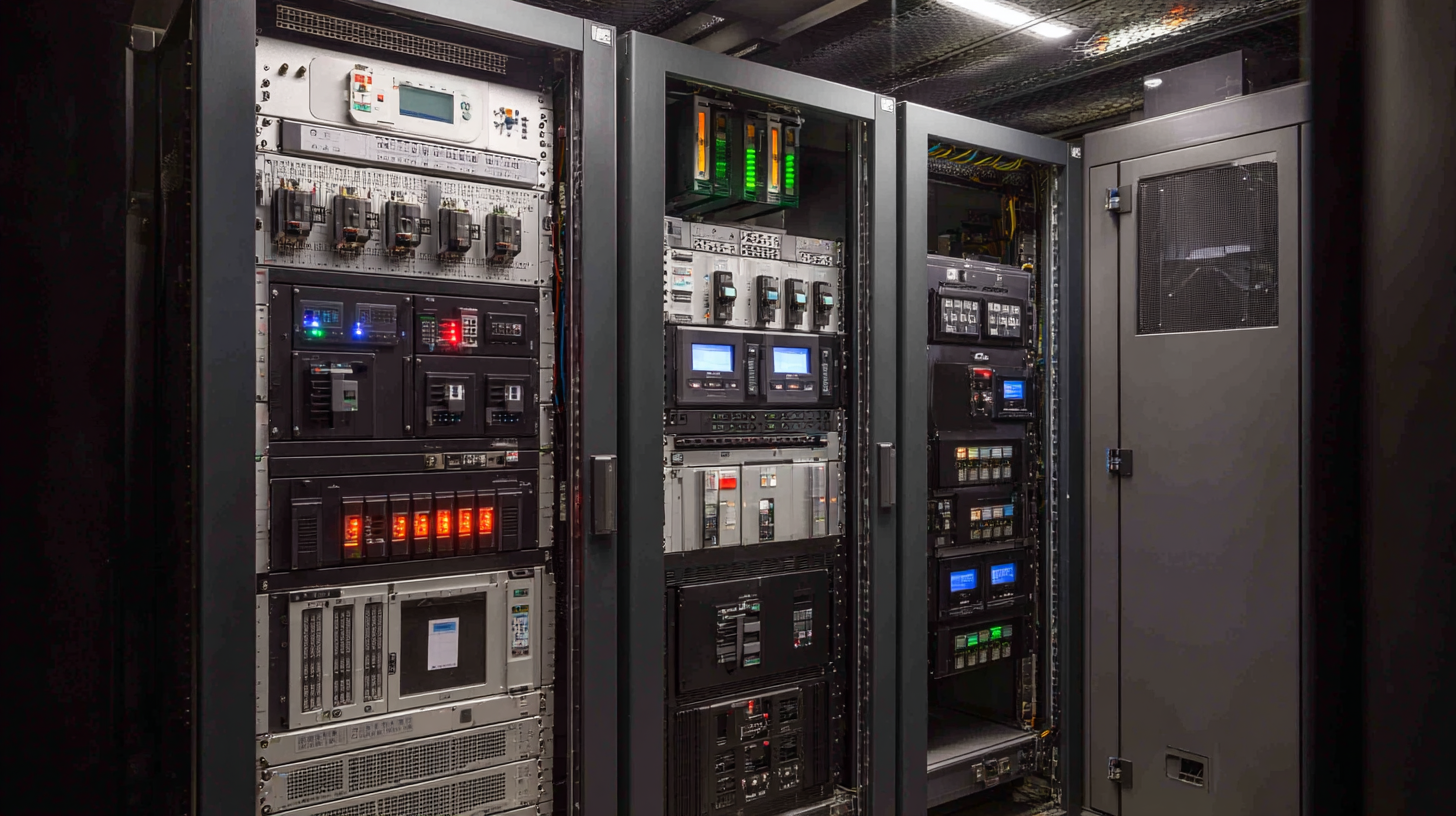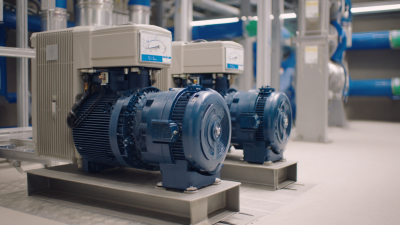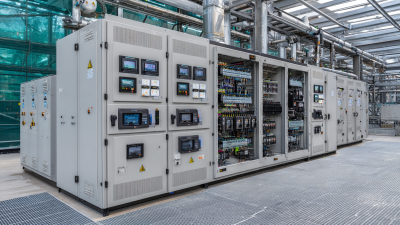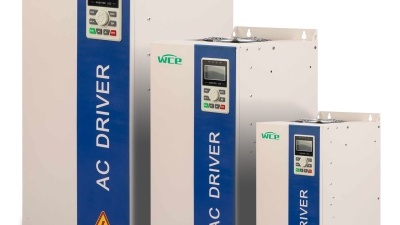Discover the Top 10 Vfd Applications for Enhanced Performance and Efficiency
Table of Contents
- Top 10 Industries Benefiting from VFD Technology Integration
- Enhancing Energy Efficiency: How VFDs Revolutionize Power Consumption
- Optimizing Motor Control: Key Advantages of VFDs in Automation Systems
- VFD Applications in HVAC: Boosting Performance and Reducing Costs
- Improving Process Control: The Role of VFDs in Manufacturing Solutions
- VFDs in Renewable Energy: Enhancing Performance in Solar and Wind Systems
- Maximize Efficiency and Control: Exploring the Benefits of the General VFD 55kw Inverter Frequency Converter for Your Motor Systems
- FAQS
- Related Posts
You know, in today’s fast-changing industrial world, Variable Frequency Drives (or VFDs for short) are becoming pretty much essential for boosting performance and efficiency across all sorts of applications. I was reading a report from MarketsandMarkets that predicts the global VFD market will hit around $25 billion by 2025, growing at about 6.9% annually. That’s a pretty clear sign that more and more industries—like manufacturing, HVAC, and water treatment—are jumping on the VFD bandwagon. At Zhejiang Chuanken Electric Co., Ltd., we’ve been in the game for 15 years, specializing in automation control products, so we totally get why these tech upgrades matter. In this post, I want to share the top 10 ways VFDs are changing industries right now—making operations smoother, cutting down energy costs, and saving companies a lot of money. Honestly, a little VFD can really transform your business and even help build a more sustainable future—pretty exciting, right?

Top 10 Industries Benefiting from VFD Technology Integration
Variable Frequency Drives, or VFDs for short, have really become game-changers across so many industries these days. They help boost performance and save energy at the same time. For instance, in manufacturing, there's quite a bit of research showing that VFDs can cut down energy use by up to half, just by fine-tuning the motor speed and torque properly. The HVAC world isn’t left out, either — these drives can cut energy bills by around 30%, which not only saves money but also helps lower the environmental impact. Oh, and in water treatment plants, VFDs have made things more reliable, giving engineers better control over pumps, which means cleaner water and smarter water-saving habits.
If you’re thinking about bringing VFD technology into your operations, try starting with a thorough energy audit — it’s a good way to spot where the biggest savings could happen. Working closely with VFD manufacturers can also help you find solutions that are just right for your specific needs. Farmers, for example, are finding that VFDs really make their irrigation systems more efficient, helping them use water more wisely and even grow bigger crops. Overall, from mining to food production, hopping on the VFD train can lead to big improvements in efficiency while keeping things more sustainable for the future.

Enhancing Energy Efficiency: How VFDs Revolutionize Power Consumption
Variable Frequency Drives, or VFDs for short, have really become a game-changer in the world of modern industry. They've totally changed the way we think about managing power use. Basically, by controlling the electrical frequency going to motors, VFDs let you fine-tune speed and torque — so your equipment only runs at what’s really needed. It’s a pretty smart way to cut down on energy waste, whether you're involved in manufacturing, HVAC systems, or other sectors.
Getting those VFDs installed isn’t just about saving on electricity bills, either. They also help your motors last longer and reduce wear and tear. Because they ramp up and down smoothly, you avoid putting extra stress on the mechanical parts, which means less maintenance and more uptime — always a good thing, right? Plus, they’re great for the environment, since they can help lower carbon emissions and make it easier to stick to green regulations. As more industries realize how important efficiency and sustainability are, it’s no surprise we’re seeing VFDs everywhere. Honestly, embracing this technology isn’t just smart — it’s pretty much essential if you want to stay competitive these days.
Optimizing Motor Control: Key Advantages of VFDs in Automation Systems
Variable Frequency Drives, or VFDs for short, have really changed the game when it comes to controlling motors in automation setups. They give us a much better grip on how fast and how hard a motor works, which means systems can be more responsive to different loads. That’s a big deal because it helps save energy and puts less wear and tear on all those mechanical parts. Honestly, it not only boosts efficiency but also cuts costs down the line, making VFDs a pretty smart choice for industries that care about being sustainable.
Plus, adding VFDs into automation setups offers some pretty awesome perks—like better control over processes and improved product quality. When you can tweak motor speeds with precision, manufacturers can keep everything running at just the right settings, which cuts down cycle times and makes products more consistent. And let’s not forget, VFDs help start and stop machines smoothly, reducing stress on the equipment and helping it last longer. As automation keeps advancing, it’s pretty clear that using VFD technology is essential for businesses wanting to stay competitive, boost performance, and save energy at the same time.
VFD Applications in HVAC: Boosting Performance and Reducing Costs
Variable Frequency Drives, or VFDs for short, have really shaken up the HVAC world. They've not only boosted how systems perform but also slashed energy costs quite a bit. Back in 2019, the market for HVAC VFDs was estimated to be around $3.16 billion, and with the push towards smarter, more energy-efficient buildings, that growth isn’t slowing down anytime soon. In fact, projections show the market growing at about an 8.5% annual rate from 2024 through 2031—talk about a hot opportunity for businesses wanting to get in on the action. If your buildings eat up a lot of electricity—say, nearly 45% of global power consumption in both industrial and commercial spaces—then using VFDs could seriously save you a ton of cash. For companies eager to boost efficiency, investing in VFD tech is definitely a smart move. Just a couple of tips: make sure you do regular maintenance to keep things running smoothly, set your speed controls wisely so they adapt to changing demand, and use some of those new monitoring tools to keep an eye on energy use in real-time.

Here at Zhejiang Chuanken Electric Co., Ltd., we’ve been in the game for over 15 years, focusing on top-notch industrial automation controls. Our experience with VFDs helps businesses improve their energy efficiency and overall performance. So, why not jump into the future of HVAC with VFDs? You'll be surprised at how much it can change your energy management — saving money and making your systems work smarter. Give it a shot, and see the difference it can make!
Improving Process Control: The Role of VFDs in Manufacturing Solutions
Variable Frequency Drives, or VFDs for short, are pretty much game-changers in today's manufacturing world. They let you fine-tune the speed and torque of electric motors with a lot of precision, which means manufacturers can really optimize how their equipment runs. And here's the cool part—by dialing back the motor speed when demand is low, VFDs help save energy and cut costs. Plus, they’re great at adjusting to different load conditions, so machinery only works as hard as it needs to, which helps extend its lifespan and reduces the need for repairs.
Adding VFDs into the mix really boosts process accuracy and gives a lot more flexibility. Think about conveyor belts, pumps, or HVAC systems—you can tweak their speeds on the fly based on what's actually needed. This not only speeds things up but also keeps product quality consistent because the process stays steady. Also, when you connect VFDs with newer tech like IoT and automation, you start gathering all kinds of useful data. That info helps identify where things can be improved, making the entire manufacturing setup more efficient and easier to keep evolving over time.
VFDs in Renewable Energy: Enhancing Performance in Solar and Wind Systems
Variable Frequency Drives, or VFDs for short, have really become a game-changer when it comes to making renewable energy systems more efficient—especially in solar and wind setups. Basically, they help control the speed and torque of motors more smoothly, which means these techs can do their job better and waste less energy. In solar power systems, VFDs are pretty much the behind-the-scenes heroes for managing pumps and fans, making sure that every bit of sunlight we capture is put to good use. They can tweak things in real-time based on how much sunlight is available, helping to boost output while cutting down on energy loss.
When it comes to wind turbines, VFDs come in handy because they help match the turbine speed to the changing wind conditions. That’s super important for getting the most power out of wind, while also protecting the equipment and making it last longer. Plus, they help stabilize the grid by ensuring that wind farms can ramp up or down smoothly, handling those natural fluctuations in wind all the time. All in all, these little drives don’t just improve how well renewable systems work—they’re a big step toward a more sustainable energy future that’s better for everyone.
Discover the Top 10 Vfd Applications for Enhanced Performance and Efficiency - VFDs in Renewable Energy: Enhancing Performance in Solar and Wind Systems
| Application Area | VFD Benefits | Efficiency Improvement (%) | Typical Use Case |
|---|---|---|---|
| Solar Inverters | Optimizes energy conversion | 10-15 | Residential solar systems |
| Wind Turbines | Enhanced speed control | 15-20 | Utility-scale wind farms |
| Hydro Generators | Improved load matching | 10-18 | Small hydroelectric plants |
| Battery Storage Systems | Precise energy management | 12-22 | Grid-integrated storage |
| Geothermal Pumps | Efficiency in heat transfer | 8-14 | Residential heating systems |
| Tidal Energy Systems | Adaptable power output | 10-16 | Coastal energy generation |
| District Heating Systems | Optimized flow control | 9-15 | Urban heating solutions |
| Biomass Energy Systems | Enhanced combustion control | 10-20 | Biomass power plants |
| Pumped Storage Systems | Efficient energy redistribution | 12-19 | Large-scale storage |
| Smart Grid Applications | Real-time data processing | 15-25 | Integrated energy management |
Maximize Efficiency and Control: Exploring the Benefits of the General VFD 55kw Inverter Frequency Converter for Your Motor Systems
In today's competitive industrial landscape, optimizing motor systems is crucial for enhancing operational efficiency and reducing energy costs. The SHCKELE SCK300 General VFD 55kw Inverter Frequency Converter stands out as an essential tool for achieving these goals. By allowing for precise control of motor speed and torque, this inverter can significantly improve the performance of various applications, from pumps to fans.
According to a 2022 report by the International Energy Agency (IEA), variable frequency drives (VFDs) can lead to energy savings of up to 50% in industrial applications, depending on the load profile. The SHCKELE SCK300 is designed with user-friendly features, ensuring that operators can easily adjust settings to maximize efficiency. Its robust build quality is backed by an 18-month warranty, reflecting confidence in its durability and reliability in demanding environments.
Moreover, using a General VFD like the SCK300 helps in reducing wear and tear on motors, which translates into lower maintenance costs and prolonged equipment lifespan. With advances in technology and increasing demands for energy efficiency, integrating the SHCKELE inverter into your motor systems could be a strategic decision that not only meets operational needs but also contributes to sustainable practices in your facility.
FAQS
: VFDs are devices that adjust the electrical frequency supplied to motors, allowing precise control over their speed and torque, thereby managing power consumption effectively.
By adjusting motor speed and torque based on need, VFDs minimize wasteful energy consumption, leading to significant energy savings in various industrial applications.
Implementing VFDs can reduce electricity costs and extend the life of motors and equipment, resulting in lower maintenance needs and increased uptime.
VFDs lower carbon emissions and help industries comply with environmental regulations by reducing overall energy consumption and promoting efficient practices.
VFDs allow for precise motor adjustments, enabling manufacturers to maintain optimal production conditions, decrease cycle times, and enhance output consistency.
VFDs facilitate smoother starts and stops in machinery, which reduces mechanical stress and wear, leading to a longer lifespan for equipment.
VFDs provide critical advantages such as improved operational efficiency, dynamic response to varying loads, and significant cost savings, making them crucial for competitiveness.
Yes, VFDs help organizations adhere to stringent environmental standards by lowering carbon emissions and promoting more sustainable energy consumption practices.
Yes, VFDs have widespread applications across many sectors, including manufacturing and HVAC systems, enhancing energy efficiency and operational performance.
By minimizing wear and tear on motors through controlled operation, VFDs lead to lower maintenance requirements and increased reliability of industrial equipment.
Related Posts
-

Unlocking Efficiency with the Benefits of the Best Pressure Booster Vfd Technology
-

Understanding Import and Export Certifications for the Best Vfd Control Board in Global Markets
-

Future Trends in VFD Market Analysis for 5.5kw Drives by 2025 with Essential Tips for Success
-

Top Strategies for Optimizing Your Operations with the Best Inverter 220V 380V VFD
-

Unlocking Efficiency with the Best Rs485 Modbus Soft Starter Advantages
-

Top 10 VFD Drive Manufacturers from China at the 137th Canton Fair


